Part of a series of articles titled Intermountain Park Science 2021.
Article
Climate Change and Other Factors Influencing the Saguaro Cactus
- Don E. Swann, Biologist, Saguaro National Park, National Park Service
- Daniel E. Winkler, Research Ecologist, Southwest Biological Science Center, U.S. Geological Survey
- Joshua L. Conver, PhD Candidate, Department of Geography and GIS, University of Cincinnati, Ohio
- Theresa Foley, Climate Science Specialist, Sonora Environmental Research Institute, Inc. (SERI)
The saguaro cacti (Carnegiea gigantea [Engelm.] Britton & Rose) is one of the world’s most iconic plants and a symbol of the desert Southwest. It is the namesake of Saguaro National Park, which was created (initially as a national monument) in 1933 to study, interpret, and protect the “giant cactus” and other unique Sonoran Desert species. Research on saguaros over the past century has revealed much about the plant’s growth, reproduction, population dynamics, and use by people and wildlife. Young saguaros grow very slowly, not reaching reproductive age until they are 35–65 years old. They produce white flowers that open at night during April through June, followed by large red fruits that are consumed by many desert animals. The saguaro fruit is also a traditional food source for the Tohono O’odham people, and the harvest of the saguaro fruit is a very important part of their culture (Bruhn 1971). Mature saguaros produce thousands of seeds each year, but establishment is episodic in that seedlings survive only during favorable periods with several consecutive years of cooler, wetter weather (Steenbergh and Lowe 1977).
The age of a saguaro can be estimated with some precision based on its height, using a generalized growth curve adjusted for local conditions. For example, in the park’s west district, a saguaro is approximately 4 inches (10.7 cm) when it is 15 years old, and approximately 7 feet (2.1 m) when it is 50 (Steenbergh and Lowe 1983). This age-height relationship provides insight into how saguaro establishment varies over time in response to land use change, climate change, and other local, regional, national and even global influences (Steenbergh and Lowe 1977, Pierson et al. 2013). For example, Drezner and Balling (2008) correlated saguaro establishment patterns across the saguaro’s US range with temperatures and precipitation trends associated with significant volcanic events that cool the entire earth.
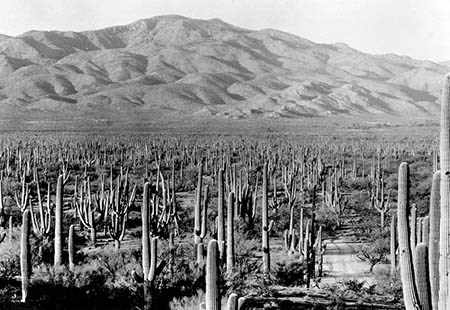
NPS photo.
Two photographs taken from the same vantage point (Turner et al. 2003) show the dramatic changes in the saguaro population of the park’s famous Cactus Forest in relation to land use changes and climatic conditions (Pierson et al 2013, Orum et al. 2016, Conver et al. 2017). In 1935 (Figure 1a), the landscape was dominated by large, mature saguaros that had established in the mid-1800s. Protective “nurse trees” (mostly foothills paloverde [Parkinsonia microphylla] and mesquite [Prosopis velutina] trees) were largely absent, having been heavily harvested during the previous five decades.
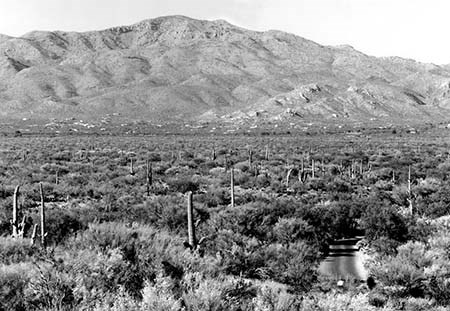
Photo USGS/Raymond Turner.
Without the trees to protect them from summer heat and winter cold, few younger saguaros survived and are largely absent from the photo. By 1998, most of the older saguaros had died (Figure 1b). However, with the protection afforded by NPS, the nurse trees had returned.
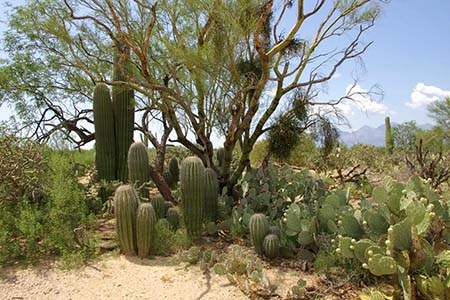
NPS photo.
What is not seen in the 1998 photo is that, beneath the new vegetation, young saguaros were slowly growing beneath these trees but were not yet visible (Figure 2). Renewed saguaro establishment in the Cactus Forest was also supported by the elimination of cattle grazing and favorable climatic conditions, especially during the 1980s (Orum et al. 2016).
Since saguaros live as long as 150 to 200 years, they would not seem to be likely candidates for studying climate change. However, the Sonoran Desert entered a period of prolonged drought in the mid-1990s, the severity of which was exacerbated by human contributions to climate change (Woodhouse et al. 2010; Overpeck and Udall 2020). Although the changing climate may not affect overall saguaro adult survival, it does influence establishment, growth, distribution, and reproduction in ways that have important implications for the park. In their analysis of 40 years of meteorological measurements from the Sonoran Desert, Weiss and Overpeck (2005) found widespread warming trends during the winter and spring, a decreased frequency of freezing temperatures, and increased minimum temperatures. In Saguaro National Park, average temperatures have followed an increasing trend of approximately 2.16 oF (1.2 oC) per century (Gonzalez et al. 2018). Now temperatures routinely exceed the historic range recorded during the last century (Monahan and Fisichelli 2014), and the park has experienced more frequent extreme summer heat events.
As part of its monitoring of the health of saguaros, Saguaro National Park is supporting and participating in research that provides insight into how this iconic plant responds to current and expected changes in precipitation and temperature. Key to this effort is ongoing measurements on saguaro research plots that were originally established during studies in the 1940s, 1960s, 1970s, and 1990s. Although these studies rarely focused on climate and only a few were originally intended to be long-term, they provide a wealth of information for scientists today. In 2017, the park also began a long-term study of how climate change affects saguaro reproduction.
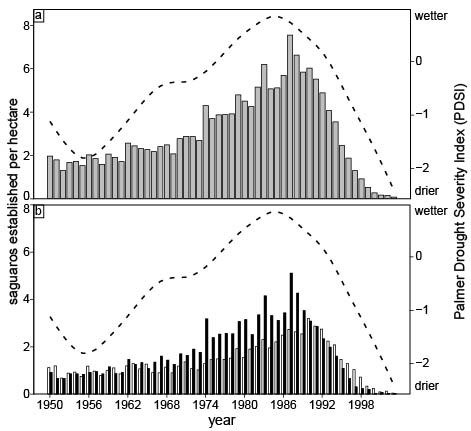
Modified from Winkler et al. 2018.
Climate change and saguaro establishment
A major concern is how a warmer and more arid climate affects the establishment of saguaro seedlings. Adult saguaros can store large amounts of water and are extremely drought-resistant, but saguaro seedlings rely on moist soils to survive during their first few years. Many studies (e.g., Drezner 2006, Pierson et al. 2013, Orum et al. 2017) have demonstrated the strong relationship between establishment of new saguaros and climatic periods with lower temperatures and higher precipitation. In a recent paper based on 10-year surveys on randomized plots in the park, Winkler et al. (2018) found that saguaro establishment park-wide is strongly positively correlated with the Palmer Drought Severity Index (PDSI), a standardized index of dryness that spans from -6 (dry) to +6 (wet) (Figure 3). In other words, when the index is less than -2, few saguaro seedlings endure. Saguaro establishment surged during the period of high annual precipitation in the 1980s but has slowed since, coinciding with a prolonged drought (Woodhouse et al. 2010). In the current drought, lower precipitation has been exacerbated by higher temperatures that dry soils (Ault et al. 2016, Weiss et al. 2009, Overpeck and Udall 2020) and may prevent younger plants from reaching a size where they are able to store sufficient water to survive. Interestingly, some saguaros have established in recent years in very rocky areas, suggesting that they may be able to take advantage of water captured in rock cracks (Winkler et al. 2018). Our research also indicates that these cracks and shade produced by rocks can provide stable microclimates that reduce exposure to temperature extremes (Conver et al. 2020).How concerned should the park be about the rarity of young saguaros less than 25 years old? Since saguaros live and reproduce for so long, they may be able to withstand years with low recruitment and probably do so in parts of their range. Nevertheless, the low establishment is cause for concern and justifies continued monitoring (Swann et al. 2018).
How temperature affects saguaro mortality and distribution
Ironically, the long-term saguaro plots established in the 1940s focused on the effects of cold weather on the plant, particularly prolonged freeze events that are relatively rare in southern Arizona (Steenbergh and Lowe 1976). Saguaros are subtropical plants that reach part of their northeastern extent in the Tucson area and persist along the isotherm where freezing temperatures last less than 24 hours (Hastings 1963). Although they can tolerate frost, Steenbergh and Lowe (1977, 1983) noted that both adult and juvenile plants are killed by below-freezing temperatures. Widespread mortality from severe freezes can alter the demographic composition and reproductive potential of local populations. Steenbergh and Lowe make a strong case that major die-offs in the Cactus Forest in the 1940s, long attributed to disease, were probably caused by freeze events in the late 1930s.
Since 1978, however, the park has only experienced one major freeze, in 2011 (Orum et al. 2016). Comparison of some of the monitoring plots before and after the 2011 freeze (in 2010 and 2014) found mortality of large adults (greater than 24 feet [7.3 m]) to be nearly 17%, while mortality of younger plants (less than 18 feet [5.5 m]) was less than 3% (Conver and Swann 2016), presumably because of the protection of younger saguaros provided by nurse plants. Twenty to 28% of saguaros greater than 18 feet ( 5.5 m) surveyed after the 2011 freeze presented some indication of frost damage, including epidermal discoloration and broken arms and tops. The results of Conver and Swann (2016) should be interpreted as minimum estimates since saguaros may not present all signs of damage or mortality for up to nine years after a freeze event (Steenbergh and Lowe 1977), so continued surveys are necessary to assess the full effect of the 2011 freeze.
Because colder temperatures in the park’s higher elevations limit the saguaro’s elevational range, could warming winters be causing the cactus to move upslope? Springer et al. (2015) tested this hypothesis with surveys between 4,000–5,000 feet (1,219–1,524 m) in elevation in the park’s Rincon Mountain District. They found that saguaros were not moving upslope; rather, wildfires are burning at lower elevations than historically, into saguaro habitat, probably due to an increase in invasive grasses. Saguaros have not evolved with fire, and large numbers in this ecotone area appear to have been killed by wildfire.
Climate, saguaro growth, and saguaro reproduction
Studies at Saguaro National Park and elsewhere have demonstrated that saguaro growth – and thus the age to reproduction – is closely tied to summer precipitation (Drezner 2008). Arizona’s monsoon rains tend to occur reliably, typically from about June 15 to September 30, but the amount of rain varies both locally and regionally. The park’s western Tucson Mountain District has historically received about 5 cm (2 in.) less rain than saguaro habitat in the eastern Rincon Mountain District, and so saguaros grow more slowly in the west (Steenbergh and Lowe 1983). Long-term monitoring in the east district also shows that saguaros gain height at a greater rate during wetter decades (Orum et al. 2017). In a current study of growth rates on the plots used by Steenbergh and Lowe to study growth in the 1970s, Conver (University of Cinncinnati, J. Conver, PhD candidate, email to Don Swann, National Park Service, Tucson, July 2018) finds that growth has slowed significantly in recent years associated with drought. Moreover, growth rates appear to be much more habitat specific than previously recognized, with growth being slower in rocky habitats where survival may be higher. Because slower-growing saguaros take longer to reproduce, changes in growth rates may ultimately have implications for reproductive potential and thereby population sustainability.
A key finding of the Fourth National Climate Assessment is that the warming climate is altering plant and animal phenology (the timing of biological events in plants and animals) (USGCRP 2017). Across much of the United States, plants are leafing out and producing flowers earlier in the year, as compared to 20th-century averages, and bird migration patterns have changed (USGCRP 2017). Is this happening with the saguaro? In the Santa Catalina Mountains near Tucson, AZ, Crimmins et al. (2010) found that the saguaro first flower date shifted to three days earlier over the 20-year study period. But a recent study in the Rincon Mountains outside the park demonstrates the timing and number of flowers varies widely in response to both temperature and highly variable winter rains (Renzi et al. 2019).
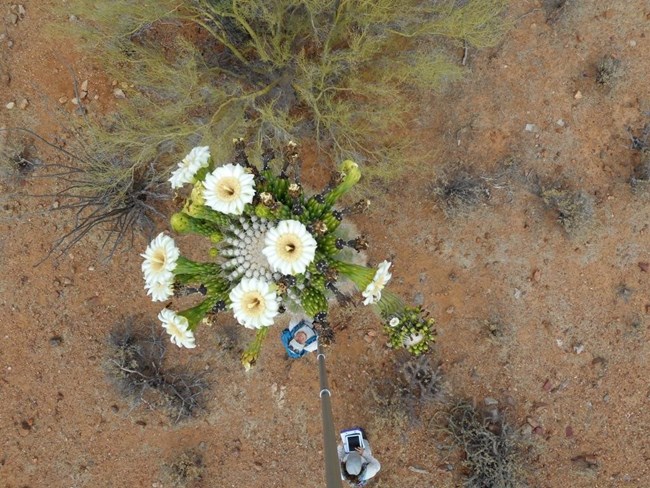
NPS photo.
Climate change, citizen science, and the future of the saguaro
Key findings of recent work on the saguaro and climate change at Saguaro National Park include:
-
Following several decades of high establishment of saguaros in the 1960s-early 1990s, establishment has slowed dramatically;
-
Poor survival of young saguaros is correlated with drought and may potentially be due to higher temperatures drying out soils more rapidly than in the past;
-
While it is speculated that saguaros may move into cooler, higher elevations due to warmer winters, we have yet to find evidence of this in the park;
-
The park and our science partners are continuing to study potential changes in reproduction and growth rates in response to changes in temperature and precipitation.
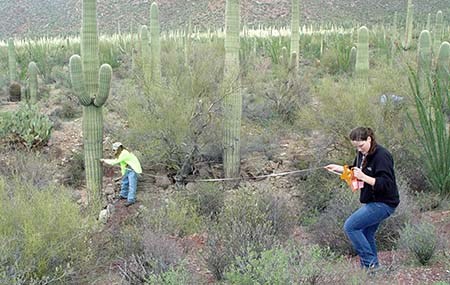
NPS photo.
Most of the research on saguaros at Saguaro National Park has a strong citizen science component. Since 1990, our main monitoring program has been the Saguaro Census, which takes place every 10 years on large, randomly located plots. In 2010 more than 300 volunteers counted, measured, and collected data on more than 20,000 individual saguaros (Figure 5). The 2020 Census, which started in October 2019 and was finished just after the start of the COVID-19 pandemic, was a similar high-profile event that has successfully linked the Tucson community with the plant that it is strongly associated with and deeply loves.
As the Sonoran Desert environment continues to change, what is the future of the saguaro in Saguaro National Park? The basic facts about the saguaro that make this question so hard to answer—its slow growth, episodic recruitment, and longevity—also make it an ideal plant to talk about in relation to the long-term impacts of the decisions we make today. Because they live longer than we do, saguaros provide a good reminder of why understanding the past and appreciating the future is not only important, but essential, for making good decisions that protect our parks for future generations.
Acknowledgements
We thank the many staff, interns and volunteers at Saguaro National Park who contributed to the data presented in this paper, particularly Kara O'Brien. We thank the following reviewers for helpful comments that improved the manuscript: S. Hejl and T. Chaudhry (NPS) and B. Ralston, T. Melis, and K. Thomas (USGS).
References
Ault, T. R., J. S. Mankin,, B. I. Cook, and J. E. Smerdon. 2016.
Relative impacts of mitigation, temperature, and precipitation on 21st-century megadrought risk in the American Southwest. Science Advances 2(10): e1600873.
Bruhn, J. G. 1971.
Carnegiea- gigantea: The saguaro and its uses. Economic Botany 25(3):320-329.
Conver, J. L., T. Foley, D. E. Winkler, and D. E. Swann. 2017.
Demographic changes over> 70 yr in a population of saguaro cacti (Carnegiea gigantea) in the northern Sonoran Desert. Journal of Arid Environments 139:41-48.
Conver, J. L., and D. E. Swann. 2016.
Re-survey of saguaro plots in Saguaro National Park following the 2011 freeze event. National Park Service Unpublished Report, Tucson, AZ.
Cover, J. L., E. Yarwood, L. D. Hetherington, and D. E. Swann. 2020.
Nurse rock microclimates significantly buffer exposure to freezing temperature and moderate summer temperature. Journal of Arid Environments 77:1-7.
Crimmins, T. M., M. A. Crimmins, and C. D. Bertelsen. 2010.
Complex responses to climate drivers in onset of spring flowering across a semi-arid elevation gradient. Journal of Ecology 98(5):1042-1051.
Drezner, T. D. 2006.
The regeneration of a protected Sonoran Desert cactus since 1800 AD over 50,000 km2 of its range. Plant Ecology 183:171–176.
Drezner, T.D. 2008.
Variation in age and height of onset of reproduction in the saguaro cactus (Carnegiea gigantea) in the Sonoran Desert. Plant Ecology 194: 223-229.
Drezner, T. D., and R. C. Balling. 2008.
Regeneration cycles of the keystone species Carnegiea gigantea are linked to worldwide volcanism. Journal of Vegetation Science 19(5): 587-596. Available at: https://doi.org/10.3170/2008-8-18430 (accessed September 17, 2020).
Gonzalez, P., F. Wang, M. Notaro, D. J. Vimont, and J. W. Williams. 2018. Disproportionate magnitude of climate change in United States national parks. Environmental Research Letters 13(10):104001.
Monahan, W. B., and N. A. Fisichelli. 2014.
Climate exposure of US national parks in a new era of change. PLOS ONE 9(7): e101302.
Orum, T. V., N. Ferguson, and J. D. Mihail. 2016.
Saguaro (Carnegiea gigantea) mortality and population regeneration in the Cactus Forest of Saguaro National Park: seventy-five years and counting. PLOS ONE 11(8): e0160899.
Overpeck, J. T., and B. Udall. 2020.
Climate change and the aridification of North America. Proceedings of the National Academy of Sciences 117:11856-11858.
Pierson, E. A., R. M. Turner, and J. L. Betancourt. 2013.
Regional demographic trends from long-term studies of saguaro (Carnegiea gigantea) across the northern Sonoran Desert. Journal of Arid Environments 88:57-69. doi:10.1016/j.jaridenv.2012.08.008.
Renzi, J. J., W. D. Peachey, and K. L. Gerst. 2019.
A decade of flowering phenology of the keystone saguaro cactus (Carnegiea gigantea). American Journal of Botany 106(2):199-210.
Springer, A. C., D. E. Swann, and M. A. Crimmins. 2015.
Climate change impacts on high elevation saguaro range expansion. Journal of Arid Environments 116:57-62. doi:10.1016/j.jaridenv.2015.02.004.
Steenbergh, W. F., and C. H. Lowe. 1976.
Ecology of the saguaro: I. The role of freezing weather in a warm-desert plant population. Research in the Parks: Transactions of the National Park Centennial symposium, National Park Service Symposium Series No. 1:49-92.
Steenbergh, W. F., and C. H. Lowe. 1977.
Ecology of the saguaro, II: reproduction, germination, establishment, growth, and survival of the young plant. National Park Service Scientific Monograph Series No. 8, 242 pages.
Steenbergh, W. F., and C. H. Lowe. 1983.
Ecology of the saguaro, III: growth and demography. National Park Service Scientific Monograph Series No. 17, 228 pages.
Swann, D. E., J. L. Conver, D. E. Winkler, and C. Harper. 2018.
Climate change and the saguaro cactus: Saguaro National Park. Natural Resource Report NPS/SAGU/NRR-2018/1583. National Park Service, Fort Collins, Colorado.
Turner, R. M., R. H. Webb, J. E. Bowers, and J. R. Hastings. 2003.
The changing mile revisited. University of Arizona Press, 334 pages.
U.S. Global Change Research Program (USGCRP). 2017.
Climate Science Special Report: Fourth National Climate Assessment, Volume I [Wuebbles, D.J., D.W. Fahey, K.A. Hibbard, D.J. Dokken, B.C. Stewart, and T.K. Maycock (editors.)]. U.S. Global Change Research Program, Washington, DC, USA, 470 pp. doi: 10.7930/J0J964J6.
Weiss, J. L., C. L. Castro, and J. T. Overpeck. 2009. Distinguishing pronounced droughts in the southwestern United States: seasonality and effects of warmer temperatures. Journal of Climate 22(22):5918-5932. doi:10.1175/2009jcli2905.1
Weiss, J. L., and J. T. Overpeck. 2005.
Is the Sonoran Desert losing its cool? Global Change Biology 11(12):2065-2077. doi:10.1111/j.1365-2486.2005.01020.
Winkler, D. E., J. L. Conver, T. E. Huxman, and D. E. Swann. 2018.
The interaction of drought and habitat explain space‐time patterns of establishment in saguaro (Carnegiea gigantea). Ecology 99:621-631.
Woodhouse, C. A., D. M. Meko, G. M. MacDonald, D. W. Stahle, and E. R. Cook. 2010.
A 1,200-year perspective of 21st century drought in southwestern North America. Proceedings of the National Academy of Sciences 107(50):21283-21288.
Last updated: August 6, 2021
